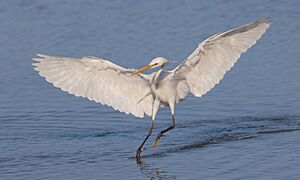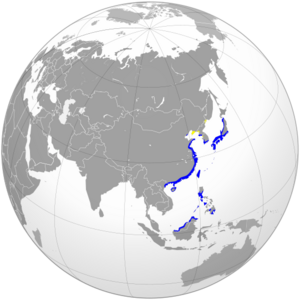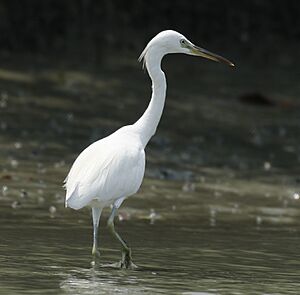Chinese egret facts for kids
Quick facts for kids Chinese egret |
|
|---|---|
 |
|
| In Zengwen River, Taiwan | |
| Conservation status | |
| Scientific classification | |
| Genus: |
Egretta
|
| Species: |
eulophotes
|
 |
|
| Yellow: breeding, green: year-round, blue: nonbreeding | |
The Chinese egret (also called Swinhoe's egret) is a beautiful white bird found in east Asia. Its scientific name is Egretta eulophotes. This egret is a threatened species, meaning it needs our help to survive. A scientist named Robert Swinhoe first described it in 1860.
Contents
What Does It Look Like?
The Chinese egret is about 68 centimeters (27 inches) tall. It has white feathers its whole life. It looks a lot like the little egret.
When it's not breeding season, its beak is dark with a peachy base. The skin around its eyes (called lores) and its legs are yellowish-green. Its eyes are yellow.
During breeding season, adult egrets grow a fancy crest of feathers on their head. This crest can be over 11 centimeters (4 inches) long! They also grow long, pointed feathers on their chest and back. These back feathers can even go past their tail.
Their colors change too in breeding season. Their beak turns a bright, almost orange, yellow. Their lores become bright blue, and their legs turn black with yellow feet.
Where Do They Live?
The Chinese egret nests on small islands. These islands are off the coasts of far eastern Russia, North Korea, South Korea, and mainland China. It used to nest in Taiwan and Hong Kong, but now it only visits these places.
During winter, or when they are traveling, you can find them in Japan, the Philippines, Vietnam, Thailand, Malaysia, Singapore, Indonesia, and Brunei.
Many Chinese egrets spend their winters in the Eastern Visayas islands in the Philippines. These islands include Leyte, Bohol, and Cebu. Large numbers also winter in the Malaysian states of Sarawak and Selangor. About one-third to half of all Chinese egrets in the world spend their winters in these areas.
Scientists estimate there are about 2,600 to 3,400 Chinese egrets left. This bird is considered a vulnerable species. This means it is at risk of becoming endangered. The biggest threat to them is losing their homes.
What Kind of Home Do They Like?
When they are not nesting, Chinese egrets live in shallow areas. They like places like tidal estuaries, mudflats, and bays. Sometimes, they visit rice fields and fish ponds. All recent nesting records show they prefer offshore islands for breeding.
How Do They Behave?
In South Korea, the first Chinese egrets arrive in mid-April. They usually have their full breeding feathers already. They first appear in small numbers on islands, especially when the weather is stormy. Most of them arrive at their nesting sites in Korea by mid-May.
Their journey south for winter is slower. Many egrets move along the west coast of Korea in August and September. They then likely leave Korea by flying southwest across the Yellow Sea. Other egrets might fly directly west from Gyeonggi Bay to the Shandong Peninsula in China. Then they fly down the Chinese coast.
Why Do They Need Our Help?
In the past, people hunted Chinese egrets for their beautiful feathers. These feathers were used to decorate hats. This practice became very popular in the 1800s. Millions of egret skins were sold, which caused the number of these birds to drop.
Today, the biggest danger to Chinese egrets is losing their habitat. People are changing tidal flats and coastal areas. This takes away the places where egrets live and find food. Pollution also harms these birds and their homes.



